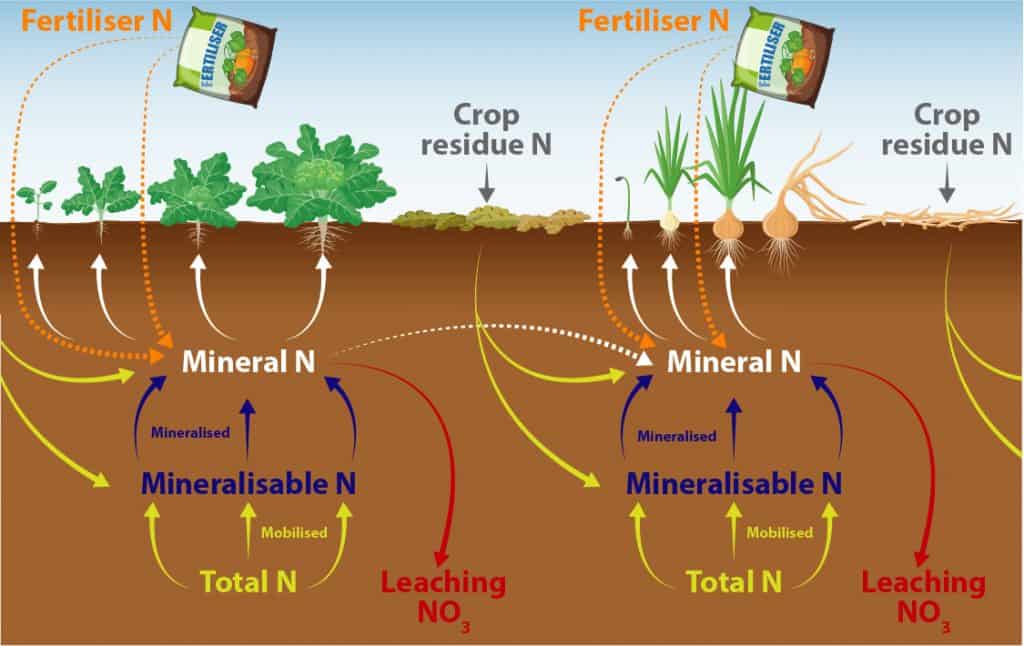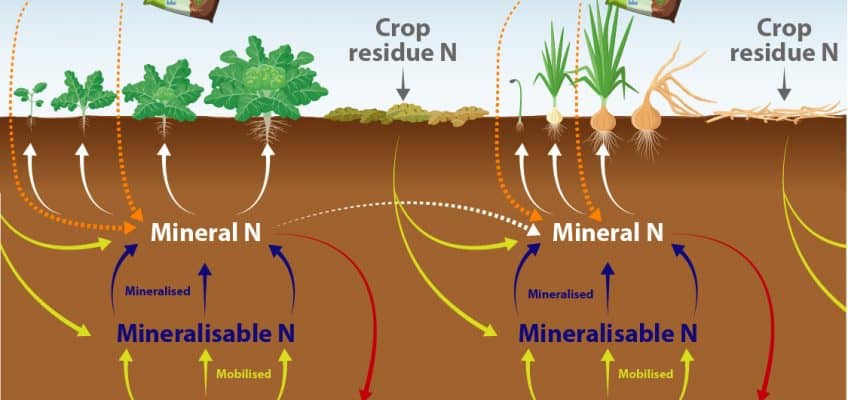Understanding soil nitrogen
Soils in New Zealand typically contain between 5000 and 9000 kg of total nitrogen (N) per hectare in the top 30 cm. Most (97-99 %) of the total soil N exists as a component of soil organic matter called the organic nitrogen fraction(included as part of Total N in Figure 1), which includes humus and soil organisms. This organic portion of soil N is not immediately available for plants to take up via their roots – it is described as being ‘immobilised’.
The other <1-3% of total soil N is in a soluble form present either as ammonium (NH4) and/or nitrate (NO3), depending upon the soil and environmental conditions. This portion of soil N is known as mineral nitrogen (Figure 1) and is the soil N that is immediately available for plants to use. The NO3 component of mineral N is the primary source of N that is at risk of being lost if excess water (rainfall or irrigation) drains through (leaches) or runs off the soil. It is also the main source of N that contributes to nitrous oxide (N2O, a greenhouse gas) emissions to the atmosphere.
There are three primary sources of N that contribute to accumulation of mineral N in soil: soil organic matter, crop residues and nitrogenous fertiliser. The breakdown of soil organic matter by soil microbes can release between 40 and 300 kg N/ha/yr through a process known as mineralisation. The rate of mineral N release is dictated by soil temperature and moisture, being faster when soils are warm and moist (but not saturated). The mineralisable N fraction makes up about 1-4% of the total organic N in most soils, but varies depending on soil type and land use history. In annual cropping systems, the plant residues that remain after crop harvest also contribute to the release of mineral N through a process known as decomposition. In addition to mineral N release, crop residue breakdown also contributes to replenishing the pool of organic N held in soil organic matter.
Although there are well established methods for soil mineral N testing and recent advances in testing for mineralisable N (see the PMN test below), there are no well-established methods for predicting the supply of N from crop residues. Though often overlooked, crop residues (including all unharvested plant tops and roots) can be a key source of N to feed the next crop. The amount of this N in residues will vary, though, depending upon the crop grown. For some crops that are known for luxury uptake of N, it also depends on the amount of N the crop had available to it during the growing season, so it pays to understand not only how much N is in the soil, but also how much N might be contained in crop residues. The timing of when this N becomes available and how much is released to the next crop therefore varies depending on crop type that was grown, as well as, of course, the environmental conditions.
To accurately work out whether addition of nitrogen fertiliser is needed to match the N demand of the next crop, it is important to know how much mineral N is in the soil, how much N will be supplied by the previous crop residues (crop residue N) and how much N will be supplied via mineralisation of soil organic matter. The rate of mineral N released from fertiliser will depend on the type, amount and placement (on soil surface or buried) of the fertiliser applied.
Soil test results can be used to help understand how much soil N is available to plants and to work out how much fertiliser N might need to be added to supplement N that is already in the soil.
Total N – this measures the total amount of organic and mineral N in the soil. Because there is so much stable N in the soil, it is not possible to measure a change in total N from one year to the next, so it is not a very useful test for growers.
Mineral N – this measures the combined amount of ammonium and nitrate in a soil sample. It is the only form of N that is taken up by plants as well as the main form of N lost via leaching and gaseous emissions, and the test result tells you how much N is immediately available to plants. It needs to be measured as soon as possible after sampling. Either refrigerate or freeze samples if they cannot be delivered to the laboratory immediately. The amount of mineral N in the soil changes during the year mainly due to plant uptake, gaseous losses or leaching.
Mineralisable N – this is the small portion of (1-4%) of the total organic N that is broken down each year by a process called mineralisation to mineral N by the action of soil microbes. Mineralisation occurs most rapidly when the soil is moist and warm. The new Potentially Mineralisable N (PMN) test provides the best measure of the mineralisable N pool in soil. Information on how to convert PMN to the kg N/ha that can be released over a crop growing season is available from most of the commercial testing laboratories in New Zealand.
Crop Residue N – there are currently no reliable methods to predict the release of mineral N from crop residues. This is an important of focus for future research.

Figure 1: A schematic diagram showing the movement of nitrogen in soil (gaseous losses not shown) during growth of a broccoli crop, followed by an onion crop, within a cropping rotation. Illustration by Donna Gibson, © Plant & Food Research.
Footnote: This article is a joint contribution from the ‘Sustainable Vegetable Systems’ and ‘Mineralisable N to improve on-farm N management’ projects, with funding from the Ministry for Primary Industries, the Vegetable Research and Innovation Board, and Horticulture New Zealand. Other co-funders include: Potatoes New Zealand, the Foundation for Arable Research, commercial testing laboratories (Hill, ARL, Eurofins) and regional councils (Canterbury, Waikato and Hawke’s Bay).



